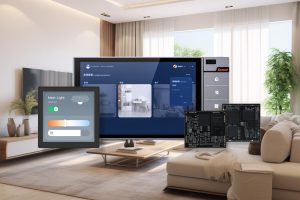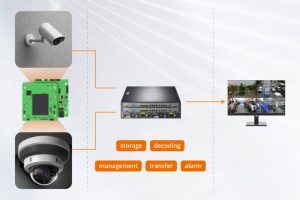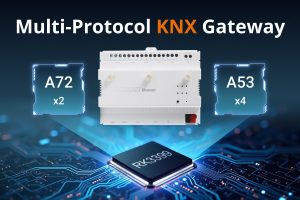DSGW-380 RK3588 Industrial AI Edge Computing Gateway Model list
| Model | WiFi6 | 5G | RS232 | RS485 | LoRa | BLE 5.2 | Ethernet |
|---|---|---|---|---|---|---|---|
| DSGW-380-1 | ● | ● | ● | ● | ● | ● | ● |
| DSGW-380-2 | ● | ● | ● | ● | ● |
1. Introduction of DSGW-380 RK3588 Industrial AI Edge Computing Gateway
The DSGW-380 is an edge computing gateway designed for AI applications based on the RK3588 chip. This chip features an integrated CPU consisting of a quad-core Cortex-A76 alongside a quad-core Cortex-A55 and is further enhanced by a NEON coprocessor. The gateway is also equipped with an NPU (Neural Processing Unit) capable of hybrid operations with INT4, INT8, INT16, and FP16 and offers a computing capacity of up to 6 TOPS. In addition, the DSGW-380 is highly compatible with various neural network models, supporting a range of frameworks such as TensorFlow, MXNet, PyTorch, and Caffe.
The rugged design with aluminum alloy structure, active fan cooling, rich I/O interfaces, and stable performance make the DSGW-380 highly suitable for various applications. These include robotics, autonomous delivery vehicles, low-altitude security, intelligent detection systems, and smart infrastructure. It is the optimal choice for implementing AI computing capabilities at the edge in deep learning scenarios.
- Supports 5G, 4G LTE CAT4 and CAT1
- Supports Wi-Fi 6 (IEEE 802.11ax)
- Offers powerful computing performance, providing high-performance processing resources for AI edge computing
- Supports a variety of industrial real-time Ethernet and fieldbus protocols, making it compatible with a wide range of industrial equipment
- Coming with rich I/O interfaces
- Supports ROS robot system
- Supports a variety of deep learning framework software, including TensorFlow, MXNet, PyTorch, and Caffe
- Includes an acceleration SDK based on the open-source YOLOV3 algorithm, which provides a variety of API interfaces
- Supports IoT wireless protocols, including BLE 5.2 and LoRaWAN
- Featuring a fully industrial design, making it rugged and ready for harsh conditions

2. Mechanical Requirement of DSGW-380 RK3588 Industrial AI Edge Computing Gateway
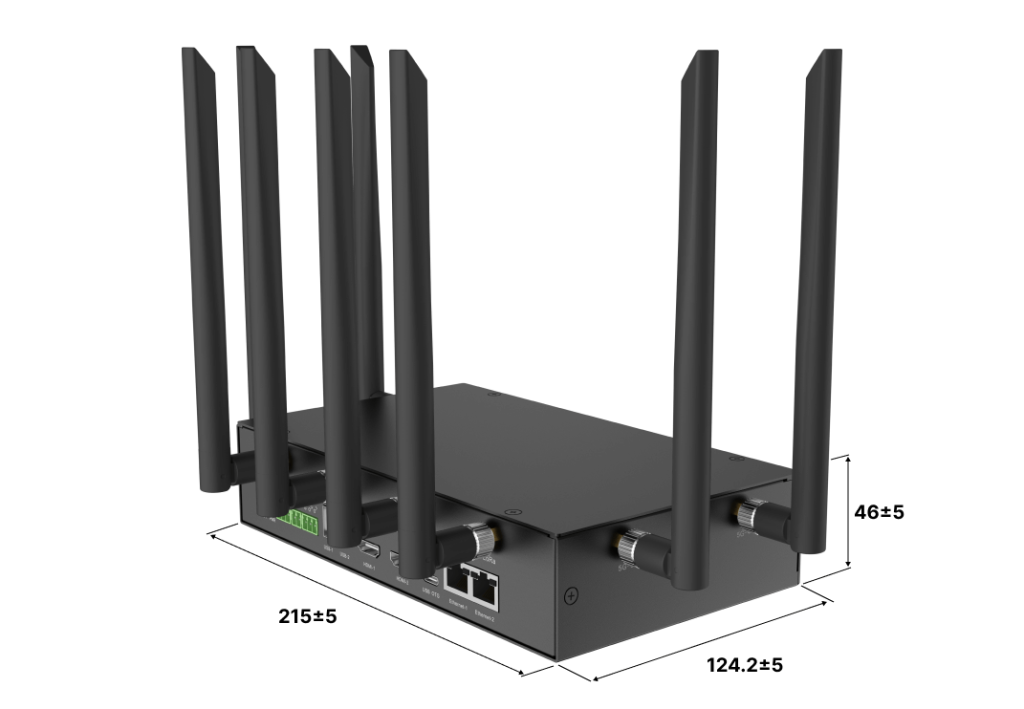
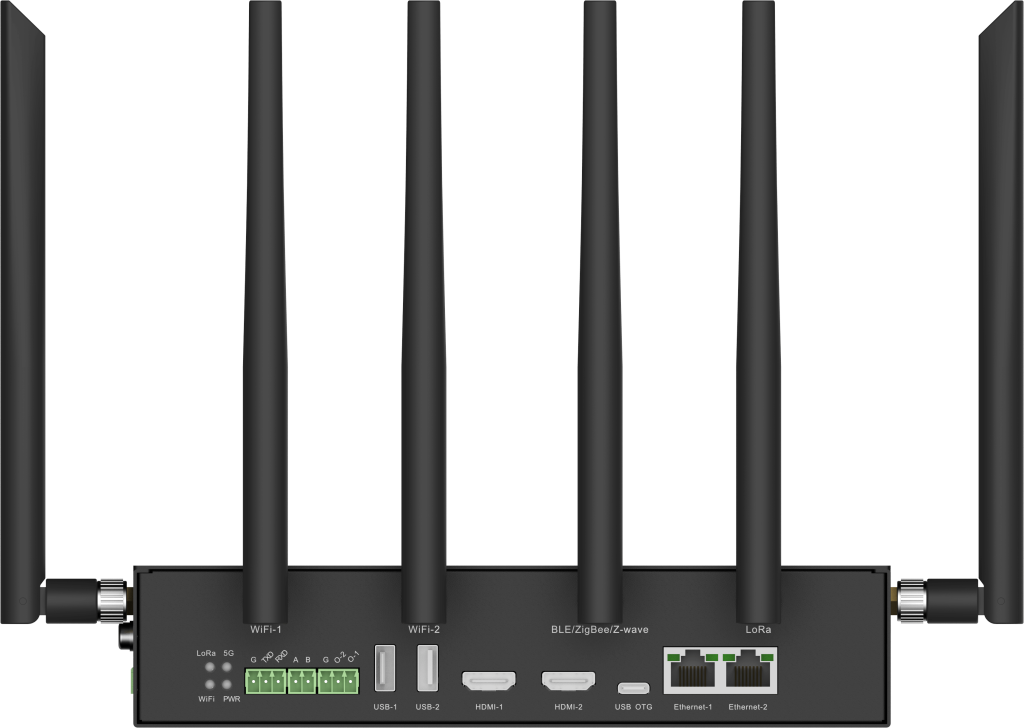
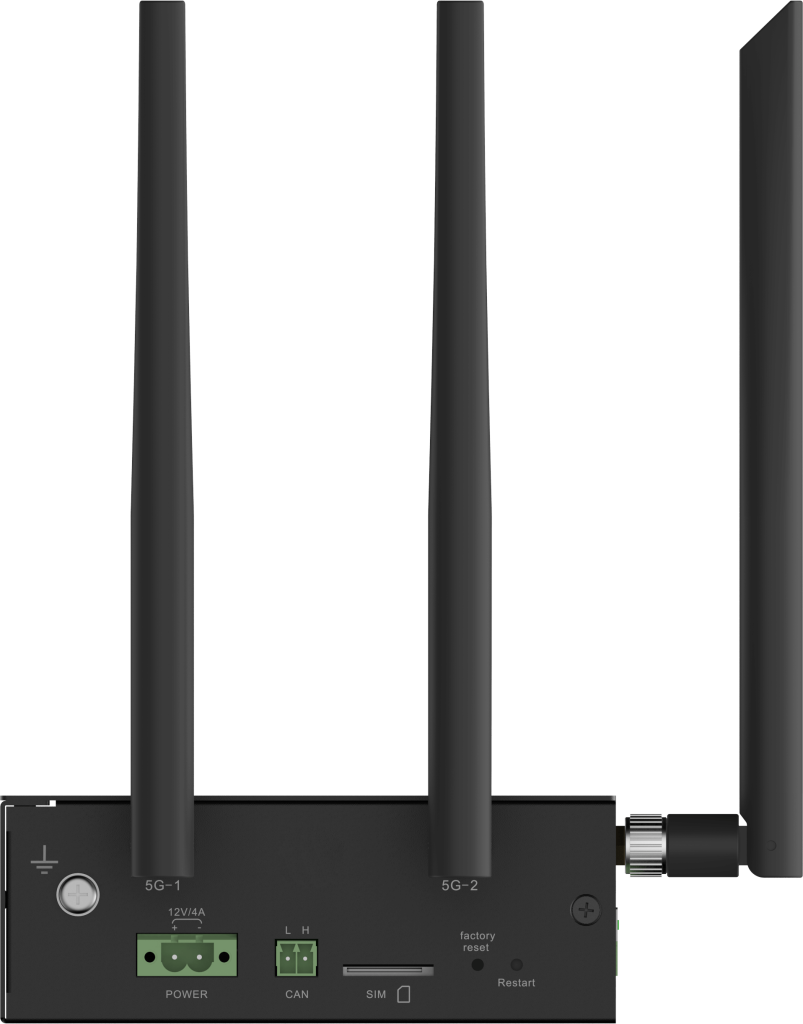
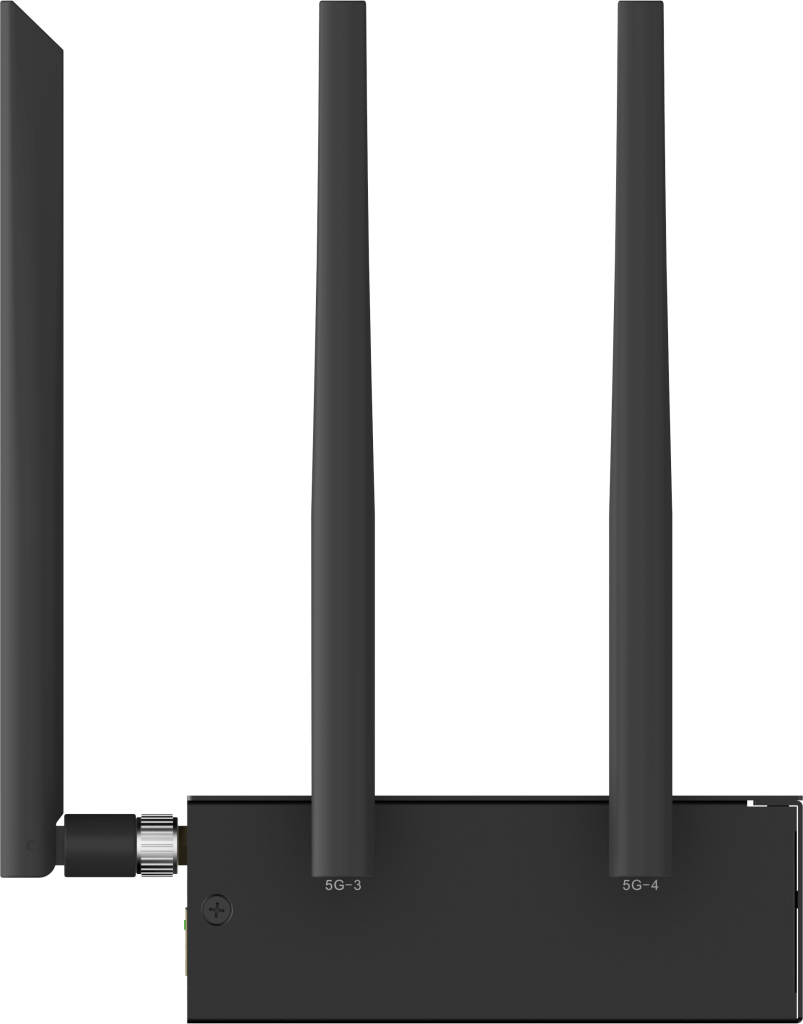
3. Specifications of DSGW-380 RK3588 Industrial AI Edge Computing Gateway
| Technical Specification | |
|---|---|
| CPU | RK3588 Quad-core ARM Cortex-A76 and Quad-core ARM Cortex-A55 |
| System | Debian 11 |
| RAM | 8 GB LPDDR4 |
| Storage | 64 GB eMMC |
| Power Supply | Input: DC 12V/4A |
| Indicator LEDs | The Power LED remains GREEN when the device is on. The 5G LED flashes BLUE when functioning correctly. The Wi-Fi LED flashes BLUE when operating properly. The LoRa LED remains BLUE when functioning correctly. |
| Reset Button | Factory reset button. To reset the Gateway to its original factory settings, press and hold it for more than 10 seconds |
| I/O Port | IO1/IO2 DI DO AI |
| Ethernet | 2 * RJ45 Gigabit |
| SIM Card Slot | 1 * SIM Card Slot |
| Antenna | 1*BLE, 4*LTE(5G), 1*LoRa, 2*Wi-Fi(2.4G/5G) |
| RS232 | 1*RS232 |
| RS485 | 1*RS485 |
| CAN | 1 |
| HDMI | 2 |
| USB Port | 2*USB3.0 |
| OTG2.0 | USB type C |
| Installation | DIN-Rail, Wall Mounting |
| Protection Rating | IP 30 |
| Shell Material | Aluminum alloy |
| Storage Temperature | -40℃~85℃ |
| Operating Temperature | -25℃~75℃ |
| Ambient Humidity | 5~95% |
| Performance Requirement | |
|---|---|
| Wi-Fi Performance | WLAN Standard: IEEE 802.11b/g/n/ax, CSMA/CA Frequency Range 2.4~2.4835GHz (2.4GHz ISM Band) Channels Ch1~Ch13 (For 20MHz Channels) Modulation: 802.11b (DSSS): CCK, DQPSK, DBPSK; 802.11g (OFDM): BPSK, QPSK, QAM16, QAM64; 802.11n (OFDM): BPSK, QPSK, QAM16, QAM64; 802.11ax (OFDMA): BPSK, BPSK_DCM, QPSK, QPSK_DCM, QAM16, QAM16_DCM, QAM64, QAM256, QAM1024; 802.11b: 1, 2, 5.5, 11Mbps; 802.11g: 6, 9, 12, 18, 24, 36, 48, 54Mbps; 802.11n (HT20): MCS0~MCS7(1T1R_SISO) 6.5~72.2Mbps; 802.11n (HT20): MCS8~MCS15(2T2R_MIMO) 13~144.4Mbps; 802.11n (HT40): MCS0~MCS7(1T1R) 13.5~150Mbps; 802.11n (HT40): MCS8~MCS15(2T2R) 27~300Mbps; 802.11ax (HE_MU,26~242RU): MCS0~MCS11(1T1R) 0.4~143.4Mbps; 802.11ax (HE_MU,26~242RU): MCS0~MCS11(2T2R) 0.8~286.8Mbps; 802.11ax(HE_SU,non-OFDMA20MHz):MCS0~MCS11(1T1R)3.6~143.4Mbps; 802.11ax(HE_SU,non-OFDMA20MHz):MCS0~MCS11(2T2R) 7.3~286.8Mbps; 802.11ax(HE_SU,non-OFDMA40MHz):MCS0~MCS11(1T1R) 7.3~286.8Mbps; 802.11ax(HE_SU,non-OFDMA40MHz):MCS0~MCS11(2T2R)14.6~573.5Mbps; Frequency Tolerance:≦±15ppm Frequency Range: 5.15~5.25GHz; 5.25~5.35GHz; 5.47~5.73GHz; 5.735~5.835GHz (5GHz ISM Band) Channels: Ch36, Ch40, Ch44, Ch48; Ch52~Ch64 Ch100~Ch140; Ch149~Ch165 (For 20MHz Channels) Modulation: 802.11a (OFDM): BPSK, QPSK, QAM16, QAM64; 802.11n (OFDM): BPSK, QPSK, QAM16, QAM64; 802.11ac (OFDM): BPSK, QPSK, QAM16, QAM64, QAM256; 802.11ax (OFDMA): BPSK, BPSK_DCM, QPSK, QPSK_DCM, QAM16, QAM16_DCM, QAM64, QAM256, QAM1024; Date Rate: 802.11a: 6, 9, 12, 18, 24, 36, 48, 54Mbps 802.11n (HT20): MCS0~MCS7(1T1R_SISO) 6.5~72.2Mbps 802.11n (HT20): MCS8~MCS15(2T2R_MIMO) 13~144.4Mbps 802.11n (HT40): MCS0~MCS7(1T1R) 13.5~150Mbps 802.11n (HT40): MCS8~MCS15(2T2R) 27~300Mbps 802.11ac (VHT20): MCS0~MCS8(1T1R) 6.5~86.7Mbps 802.11ac (VHT20): MCS0~MCS8(2T2R) 13~173.3Mbps 802.11ac (VHT40): MCS0~MCS9(1T1R)13.5~200Mbps 802.11ac (VHT40): MCS0~MCS9(2T2R)27~400Mbps 802.11ac (VHT80): MCS0~MCS9(1T1R)29.3~433.3Mbps 802.11ac (VHT80): MCS0~MCS9(2T2R)58.5~866.7Mbps 802.11ax (HE_MU,26~484RU): MCS0~MCS11(1T1R) 0.4~286.8Mbps 802.11ax (HE_MU,26~484RU): MCS0~MCS11(2T2R) 0.8~573.5Mbps 802.11ax (HE_SU,non-OFDMA 20MHz): MCS0~MCS11(1T1R) 3.6~143.4Mbps 802.11ax (HE_SU,non-OFDMA 20MHz): MCS0~MCS11(2T2R) 7.3~286.8Mbps 802.11ax (HE_SU,non-OFDMA 40MHz): MCS0~MCS11(1T1R) 7.3~286.8Mbps 802.11ax (HE_SU,non-OFDMA40MHz):MCS0~MCS11(2T2R) 14.6~573.5Mbps 802.11ax (HE_SU,non-OFDMA80MHz):MCS0~MCS11(1T1R) 15.3~600.4Mbps 802.11ax (HE_SU,non-OFDMA80MHz): MCS0~MCS11(2T2R) 30.6~1201Mbps |
| Bluetooth Performance | •TX Power: 19.5dBm •Range: 150 meters minimum, open filed •Receiving Sensibility: [email protected]%BER •Frequency offset: +/-20KHZ •Frequency Range (MHz):2401.0~2483.5 •Low Frequency (MHz):2400 •High Frequency (MHz):2483.5 •E.i.r.p (Equivalent Isotopically Radiated power) (mW)<10mW •Bandwidth (MHz):2MHz •Modulation: GFSK |
| 5G RM500Q-CN/ RM500Q-AE/RM502QAE/ RM505Q-AE |
•5G SA Sub-6: Max. 2.1Gbps (DL)/ Max. 900Mbps (UL) •5G NSA Sub-6: Max. 2.5Gbps (DL)/Max. 525/550Mbps (UL) •5G SA Sub-6: Max. 2.1Gbps (DL)/Max. 450Mbps (UL)(RM500Q-AE/ RM505Q-AE); Max. 4.2Gbps (DL)/Max. 450Mbps (UL)(RM502Q-AE) •5G NSA Sub-6: Max. 2.5Gbps (DL)/Max. 650Mbps (UL)(RM500Q-AE/ RM505Q-AE); Max. 5.0Gbps (DL)/Max. 650Mbps (UL)(RM502Q-AE) •LTE-FDD: Max. 1Gbps (DL)/Max. 200Mbps (UL) •LTE-FDD: Max. 1Gbps (DL)/Max. 200Mbps (UL) (RM500Q-AE/RM505Q-AE) •LTE-FDD: Max. 2Gbps (DL)/Max. 200Mbps (UL) (RM502Q-AE) 5G NR: n1/n28/n41/n78/n79 •LTE-FDD: B1/B3/B5/B8 •LTE-TDD: B34/B38/B39/B40/B41 •WCDMA: B1/B8 •5GNR:n1/n2/n3/n5/n7/n8/n12/n20/n25/n28/n38/n40/n41/n48/n66/n71/n77/n78/n79 •LTE-FDD: B1/B2/B3/B4/B5/B7/B8/B12(B17)/B13/B14/B18/B19/B20/B25/B26/B28/B29/B30/B32/B66/B71 •LTE-TDD: B34/B38/39/B40/B41/B42/B43/B4 |
4. QA Requirements of DSGW-380 RK3588 Industrial AI Edge Computing Gateway
| Information Description | Standard(Yes) custom(No) | |||||
| ESD Testing | Yes | |||||
| RF Antenna Analysis | Yes | |||||
| Environmental Testing | Yes | |||||
| Reliability Testing | Yes | |||||
| Certification | FCC, CE, SRRC | |||||
| DUSUN IIOT Gateway selection table | |||||
|---|---|---|---|---|---|
| Name | LS1021 Industry Router Gateway | i.MX6 Industry Edge Gateway | i.MX8m lift IIOT Gateway | i.MX6ull air compress IIOT Gateway | RK3588 AI IIOT Gateway |
| Model | DSGW-080 | DSGW-081 | DSGW-089 | DSGW-410 | DSGW-380 |
| Picture |  |
 |
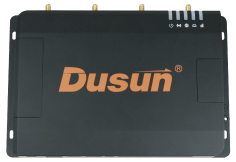 |
 |
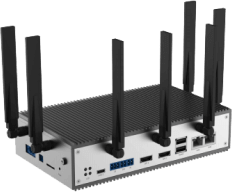 |
| CPU | LS1021 | i.MX6ull | i.MX8m | i.MX6ull | RK3588 |
| RAM | 1GB | 512MB | 1GB | 512MB | 8GB |
| FLASH | 8GB eMMC | 8GB eMMC | 8GB eMMC | 8GB eMMC | 128GB |
| OS | Linux | Debian | Yocto | Debian | Debian/RoS/ubuntu |
| POWER | Power supply:12~48V DC | Power supply: DC 12V | Input: DC 12V~24V | Power supply: DC 12V and PoE | Power supply:12V and POE |
| Ethernet | 2x10/100Mbps | 1x10/100Mbps | 1x10/100Mbps | 1x10/100Mbps | 1*RJ45 port |
| Li battery | / | / | Lasts 1~2 hours | / | / |
| Bluetooth | BLE5.1 | BLE5.1 | BLE5.2 | BLE5.3 | BLE5.4 |
| Wi-Fi | IEEE802.11n; IEEE802.11g; IEEE802.11b | IEEE802.11n; IEEE802.11g; IEEE802.11b | IEEE802.11n; IEEE802.11g; IEEE 802.11b | Wi-Fi mesh | Wi-Fi6 |
| ZigBee | zigbee3.0 | zigbee3.0 | / | / | / |
| Sub-G | / | / | / | SuB-G | |
| Cellular network | LTE Cat4;5G(option) | LTE Cat4 | LTE Cat4 | LTE Cat1 | 5G |
| Interface | RS485;RS232;I/O | CAN;RS485;RS232;I/O;USB | CAN;RS485;RS232;I/O; Audio | CAN; | CAN;RS485;RS232;I/O;USB |
| Industry protocol | BACnet; Profinet; Ethernet/IP; Modbus; OPC/UA | BACnet; Profinet; Ethernet/IP; Modbus; OPC/UA | BACnet; Profinet; Ethernet/IP; Modbus; OPC/UA | OPC/UA | BACnet; Profinet; Ethernet/IP; Modbus; OPC/UA |
| Certification | CE、FCC、RoHS | CE、FCC、RoHS | CE、FCC、RoHS | CE、FCC、RoHS | CE、FCC、IC、RoHS |
| Application | Industrial Communication | PLC | Lift | air compress | Industrial AI recognition |















